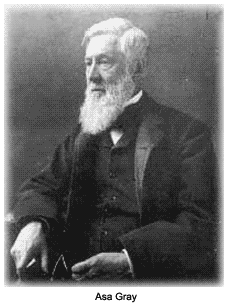The "Father of American Botany," Asa Gray is often regarded by scholars as the most important American botanist of the 19th century.
He was a student of John Torrey*, for whom the Torrey Pine is named. Together they produced a cutting-edge botanical guide that is now one of the standards in the field, Flora of North America (1843).
 The Early Years
The Early Years
Asa Gray was born in Paris, New York, south of Utica, in November 1810. He was a farmer's son. His formal education was gained at the Fairfield Academy and the Fairfield Medical School, both in Fairfield, New York.
From Dr. James Hadley, the professor of chemistry and medicine, Asa obtained his first instruction in science (1825 to 1826). In the spring of 1827, at age 16, he began to collect and identify plants. His formal education ended in February 1831, when he took the M.D. degree at age 20.
After practicing medicine for a while, Gray turned his attention to his first love: collecting plants. His first contribution to descriptive botany appeared in 1835. For the following 53 years, an uninterrupted series of contributions to systematic botany cascaded from his quill.
Master Botanist
In 1836, Gray's first botanical textbook appeared under the title, Elements of Botany, followed in 1839 by his Botanical Text-Book for Colleges, Schools, and Private Students, which developed into his Structural Botany.
Gray was the first to bring continuity and consistency to the language of botany. He published Gray’s Botanical Text-Book in 1842, which standardized botanical terminology in English-speaking countries.
Also in that year, at age 31, Gray accepted the Fisher Natural History professorship at Harvard. He oversaw activities at the Harvard Botanic Garden and watched it grow over the next 31 years into one of the finest gardens in the U.S. and all of North America.
A prodigious writer, Gray produced several textbooks dealing with specifics regarding numerous disciplines within the field. His Manual of Botany (1847) is often called his most important work, and it enjoys “classic” status. Even though the work has undergone a number of editions, it remains clear, accurate, and compact to an extraordinary degree, and within its geographical limits, is “an indispensable book for the student of American botany.”
Other volumes that served to inspire popular interest in botanical studies include First Lessons in Botany and Vegetable Physiology (1857), How Plants Grow (1858), Field, Forest, and Garden Botany (1869); and How Plants Behave (1872).
With Charles Darwin and John Muir
When Charles Darwin was collating his enormous stack of information and observations leading to his opus, Origin of Species (1859), he often consulted Gray to confirm his theories, such as whether or not plants in Japan and northeast Asia were similar to those appearing at the same latitudes in North America (they were, to some extent).
Gray became a sympathetic exponent of Darwin and most of his theories of evolution, often butting heads with such fundamentalist colleagues as Louis Agassiz. Gray was not fully comfortable with the “selection” notion of Darwinism. He argued that, in an age when evolution was denigrated as the equivalent of atheism, such a radical theory as evolution actually was compatible with religious belief. Therefore, he leaned toward a “theistic evolutionism” theory.
It was fitting that two nationally renowned naturalists should cross paths at least once during their working careers. And so it was between Asa Gray and John Muir, though it was Gray who sought out the latter in his glorious Yosemite/Sierra domain. Muir and Gray conducted several botanical expeditions together. Gray also named some plants after Muir, which Muir had collected for him.
An example was Muir's Fleabane, Erigeron muirii, a daisy-like member of the aster family. Gray classified the species from a sample sent to him from Alaska by Muir. The plant was discovered near Cape Thompson in northwestern Alaska.
Namesakes
Asa Gray blazed many a trail in American botany. For his diligence, the master botanist has been immortalized by named places and awards, including the Gray Herbarium at Harvard and the American Society of Plant Taxonomists’ highest honor, the Asa Gray Award, established in 1984. It honors a living botanist for career achievements.